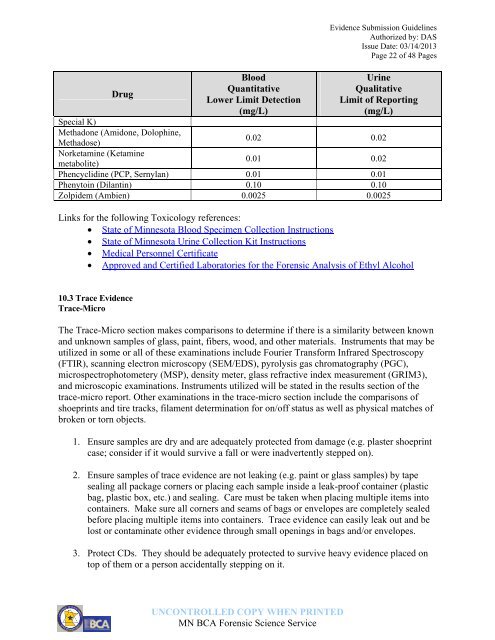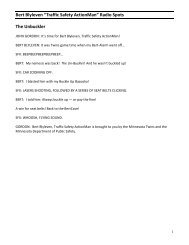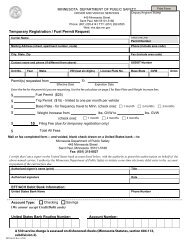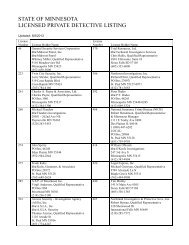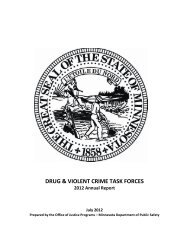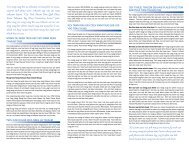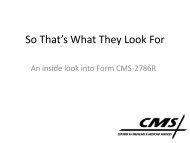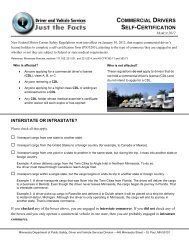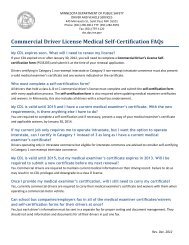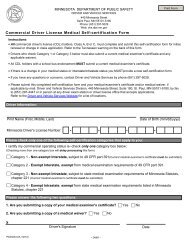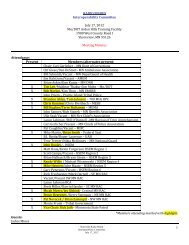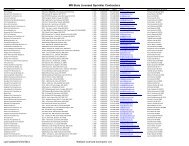Evidence Submission Guidelines - Minnesota Department of Public ...
Evidence Submission Guidelines - Minnesota Department of Public ...
Evidence Submission Guidelines - Minnesota Department of Public ...
Create successful ePaper yourself
Turn your PDF publications into a flip-book with our unique Google optimized e-Paper software.
Drug<br />
Special K)<br />
Methadone (Amidone, Dolophine,<br />
Methadose)<br />
Norketamine (Ketamine<br />
metabolite)<br />
Blood<br />
Quantitative<br />
Lower Limit Detection<br />
(mg/L)<br />
UNCONTROLLED COPY WHEN PRINTED<br />
MN BCA Forensic Science Service<br />
<strong>Evidence</strong> <strong>Submission</strong> <strong>Guidelines</strong><br />
Authorized by: DAS<br />
Issue Date: 03/14/2013<br />
Page 22 <strong>of</strong> 48 Pages<br />
Urine<br />
Qualitative<br />
Limit <strong>of</strong> Reporting<br />
(mg/L)<br />
0.02 0.02<br />
0.01 0.02<br />
Phencyclidine (PCP, Sernylan) 0.01 0.01<br />
Phenytoin (Dilantin) 0.10 0.10<br />
Zolpidem (Ambien) 0.0025 0.0025<br />
Links for the following Toxicology references:<br />
State <strong>of</strong> <strong>Minnesota</strong> Blood Specimen Collection Instructions<br />
State <strong>of</strong> <strong>Minnesota</strong> Urine Collection Kit Instructions<br />
Medical Personnel Certificate<br />
Approved and Certified Laboratories for the Forensic Analysis <strong>of</strong> Ethyl Alcohol<br />
10.3 Trace <strong>Evidence</strong><br />
Trace-Micro<br />
The Trace-Micro section makes comparisons to determine if there is a similarity between known<br />
and unknown samples <strong>of</strong> glass, paint, fibers, wood, and other materials. Instruments that may be<br />
utilized in some or all <strong>of</strong> these examinations include Fourier Transform Infrared Spectroscopy<br />
(FTIR), scanning electron microscopy (SEM/EDS), pyrolysis gas chromatography (PGC),<br />
microspectrophotometery (MSP), density meter, glass refractive index measurement (GRIM3),<br />
and microscopic examinations. Instruments utilized will be stated in the results section <strong>of</strong> the<br />
trace-micro report. Other examinations in the trace-micro section include the comparisons <strong>of</strong><br />
shoeprints and tire tracks, filament determination for on/<strong>of</strong>f status as well as physical matches <strong>of</strong><br />
broken or torn objects.<br />
1. Ensure samples are dry and are adequately protected from damage (e.g. plaster shoeprint<br />
case; consider if it would survive a fall or were inadvertently stepped on).<br />
2. Ensure samples <strong>of</strong> trace evidence are not leaking (e.g. paint or glass samples) by tape<br />
sealing all package corners or placing each sample inside a leak-pro<strong>of</strong> container (plastic<br />
bag, plastic box, etc.) and sealing. Care must be taken when placing multiple items into<br />
containers. Make sure all corners and seams <strong>of</strong> bags or envelopes are completely sealed<br />
before placing multiple items into containers. Trace evidence can easily leak out and be<br />
lost or contaminate other evidence through small openings in bags and/or envelopes.<br />
3. Protect CDs. They should be adequately protected to survive heavy evidence placed on<br />
top <strong>of</strong> them or a person accidentally stepping on it.


